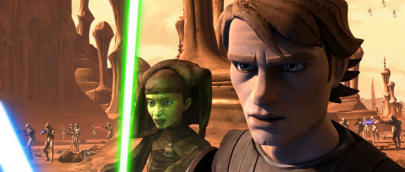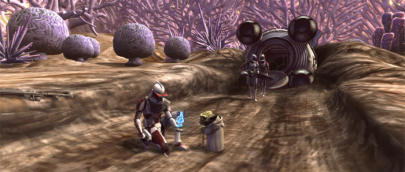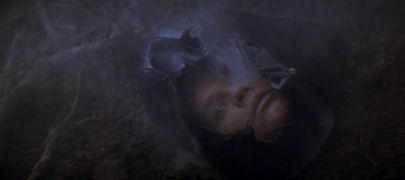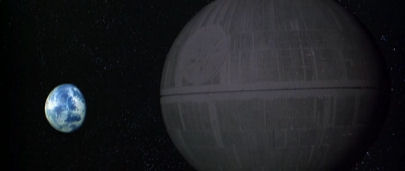In the fourth episode of this second season of The Clone Wars, we see yet another experiment in genre, this time integrating the thriller into the Star Wars universe. Senate Spy, apparently based on the Alfred Hitchcock classic Notorious, mixes intrigue with stunning locales, all-the-while setting-up a new story arc that will continue for several episodes to come.
Padme Amidala has been requested by the Jedi Council to spy on Rush Clovis, a fellow senator and delegate of the InterGalactic Banking Clan, in order to uncover ties between the Banking Clan and the Separatists. But Amidala and Clovis were once “good friends”, leading Anakin Skywalker to worry that the flame of romance may be rekindled between his (secret) wife and this charming Scipian.
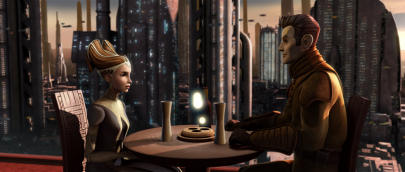
Padme Amidala and Rush Clovis share a dinner on Coruscant
The fortune cookie this week refers to Anakin’s jealousy: “A true heart should never be doubted.” Jealousy and possessiveness, of course, are functions of unhealthy attachment — that which ultimately turns Anakin to the Dark Side — but here we get to see a gentler, and sometimes more humorous take on the same theme, as Anakin tosses Clovis around in the back of a Naboo star skiff with some deliberately rough piloting. And, once again, the idea that “duty” should supersede personal considerations is raised, but also in a more light-hearted manner.
In terms of political machinations, however, this has to be one of the most densely-packed episodes to date, nicely fleshing-out the relationships between corporate entities, the Separatists and the Republic, while also adding a few new twists in the process.
The important point to remember is that the InterGalactic Banking Clan never openly aligned themselves with the Separatists in Attack of the Clones. They may have agreed to help equip and arm the Separatist forces, but this agreement was made behind closed doors. As Senate Spy reveals, ostensibly the Banking Clan merely manages debts between lending institutions and debtors such as the Trade Federation, as well as other related transactions (presumably on a suitably large scale). Business is business, after all.
Similarly, the Trade Federation may be conspiring with Count Dooku, but just as in the case of the Battle of Naboo, we have a situation where an organising body can remain untainted despite the actions of its viceroy. Captain Panaka may have had tough words to say at the end of The Phantom Menace (i.e. “I think you can kiss your trade franchise goodbye”), but nothing eventuated. Why should things be different this time?

Lott Dod, delegate for the Trade Federation
Here we have a political climate which allows for corporate interests to not just lobby senators, but to actually have representatives in the Galactic Senate itself. How could there ever be justice or fairness in such a world?
One on level, George Lucas is commenting on the enormous power wielded by corporate interests in our own world. The tobacco lobby, for example, represents the interests of companies who continue to sell a product featuring known chemical carcinogens, yet the lobby itself still exists and still has great political power. Giving them a seat in the Senate would really just be the logical extension of these politics of corruption.
On a deeper level, the question here really is, can your ethics be bought and sold? If you’re a hero on his journey, you need to turn away from that call to the Dark Side: like Luke Skywalker in The Empire Strikes Back, you resist the temptation, pull back and even take a leap into the unknown rather than sell your soul.
But others instead choose not to rise to the challenge: they serve their own egos first and foremost, and so, of course, they turn a blind eye to corruption, thereby becoming corrupt themselves. This is indeed “the quick and easy path”, and it’s not just a danger in that galaxy far, far away.
Will you be a hero? Will you accept the call to adventure and turn away from the Dark Side of the Force? Heroes and heroines are made, not born — they are every man or woman who ignores temptation and continues on their journey, no matter the personal cost. We can all be heroes, if we make that same choice.




 A brief note from the author of “Myth in Space”:
A brief note from the author of “Myth in Space”: